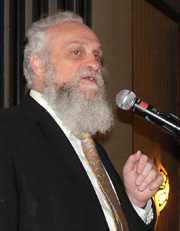By Eric Nusbaum, Assistant Editor, JTNews
Eli Genauer’s family has been part of the Bikur Cholim-Machzikay Hadath Orthodox congregation since 1909. Genauer, who on March 6 was honored with his wife Eva at the synagogue’s 120th anniversary gala, says the BCMH story is also Seattle’s story. As the city has grown from a transport center to a technological hub, the congregation has gotten younger and larger.
“At the hundredth anniversary, our president used an expression: Founders and finders,” Genauer said. “I think it’s a good mix of old-timers and their families with a lot of newcomers. Without the newcomers there wouldn’t be the growth.”
Larry Russak, a third-generation member of the Orthodox congregation and also its president, notes that his grandchildren are the fifth generation of his family to be a part of Seattle’s oldest synagogue.
Russak points to constancy as a reason for his congregation’s staying power; times may change, but BCMH stays true to its roots.
“The average level of observance is much higher than it was at any point in the last 20 years,” Russak told JTNews. “I think it’s more of a swing toward traditionalism.”
BCMH celebrated that swing, as well as the ebbs and flows of its 120-year history at a dinner event on March 6 at the SeaTac Marriott. The sold-out gala featured Richard Joel, president of Yeshiva University and former national Hillel director, as keynote speaker.
BCMH started out as Chevra Bikur Cholim, or the Society to Visit the Sick, which incorporated in 1891, according to a book on Washington’s Jewish history, Family of Strangers. As Seattle became a more popular transport hub in the wake of the Klondike gold rush, local Jewish citizens saw a need for basic services such as medical assistance and a proper Jewish cemetery. The cemetery, just off Aurora Ave. near Shoreline, predates the congregation’s first actual structural home.
In 1898, Bikur Cholim moved into its first synagogue on 13th Avenue and South Washington Street in the Central District. A decade later, the congregation again moved, this time a few blocks away to a location on 17th Avenue and Yesler Way. In 1962, Bikur Cholim merged with a young congregation called Yavneh and formed a Seward Park branch.
Jewish families both Ashkenazi and Sephardic continued to move south from the Central District, and by 1970, that branch had become the heart of Bikur Cholim itself. The Central District synagogue was sold, and in early 1971 ground was broken on the synagogue’s South Morgan Street location, where it remains today. That same year, Bikur Cholim merged with Machzikay Hadath, the Central District’s last remaining Orthodox shul, to form what is still Bikur Cholim-Machzikay Hadath. Those who stayed behind in the Central District formed what’s now called the BCMH Capitol Hill Minyan. This year also marks those two important 40-year milestones in the congregation’s history.
Genauer also noted that BCMH has, in 120 years, become an institution with reach beyond even the Northwest. Rabbi Moshe Kletenik is currently president of the Rabbinical Council of America, an Orthodox organization of about 1,000 rabbis. He’s the first president of the organization to hail from the Northwest, and one of a handful to come from outside the New York area.
“Obviously Rabbi Kletenik is deserving of that honor, but also that he’s the rabbi at BCMH was taken into consideration,” Genauer said. “I think it shows the respect that our synagogue, which is 120 years old, has not just locally but nationally.”
